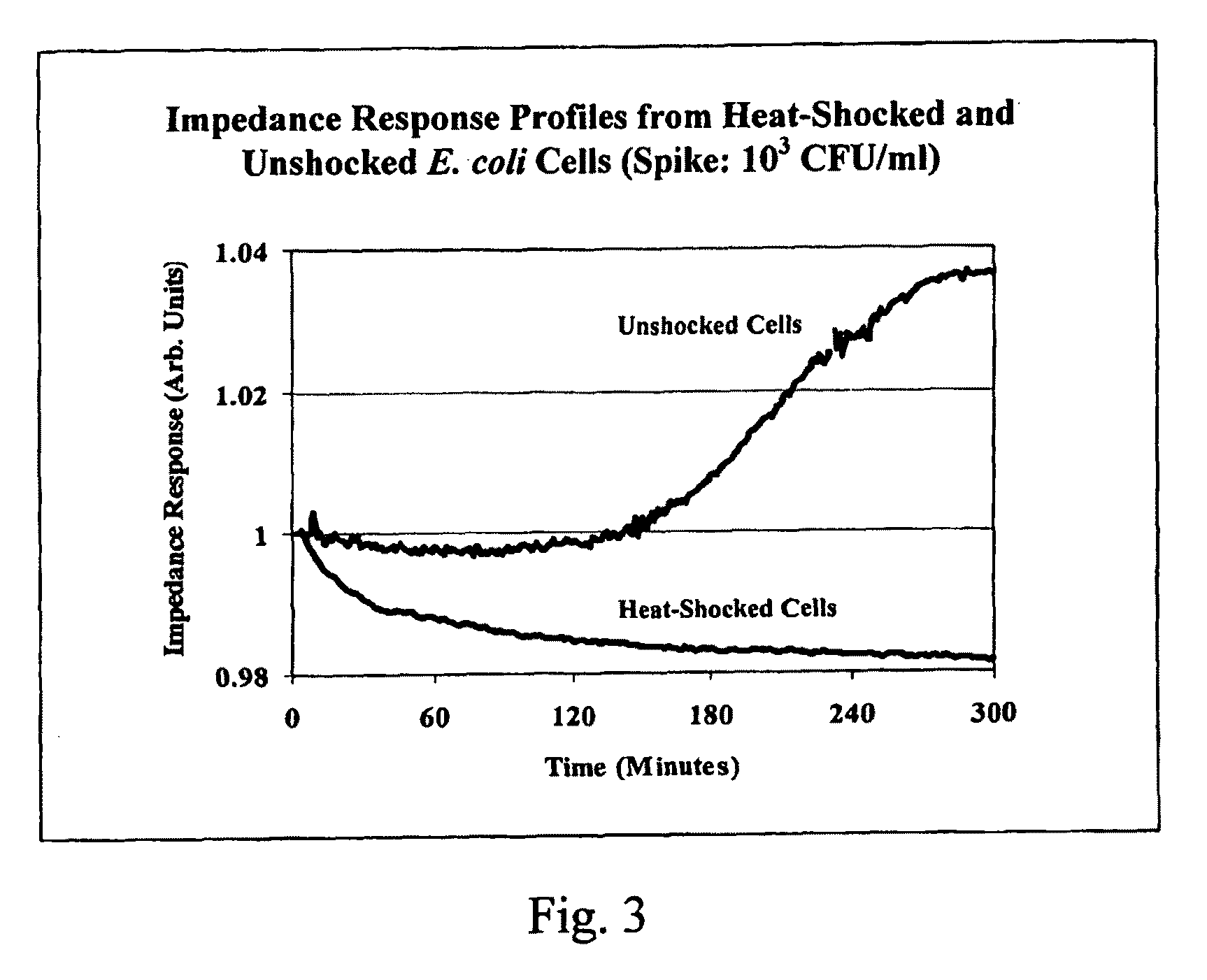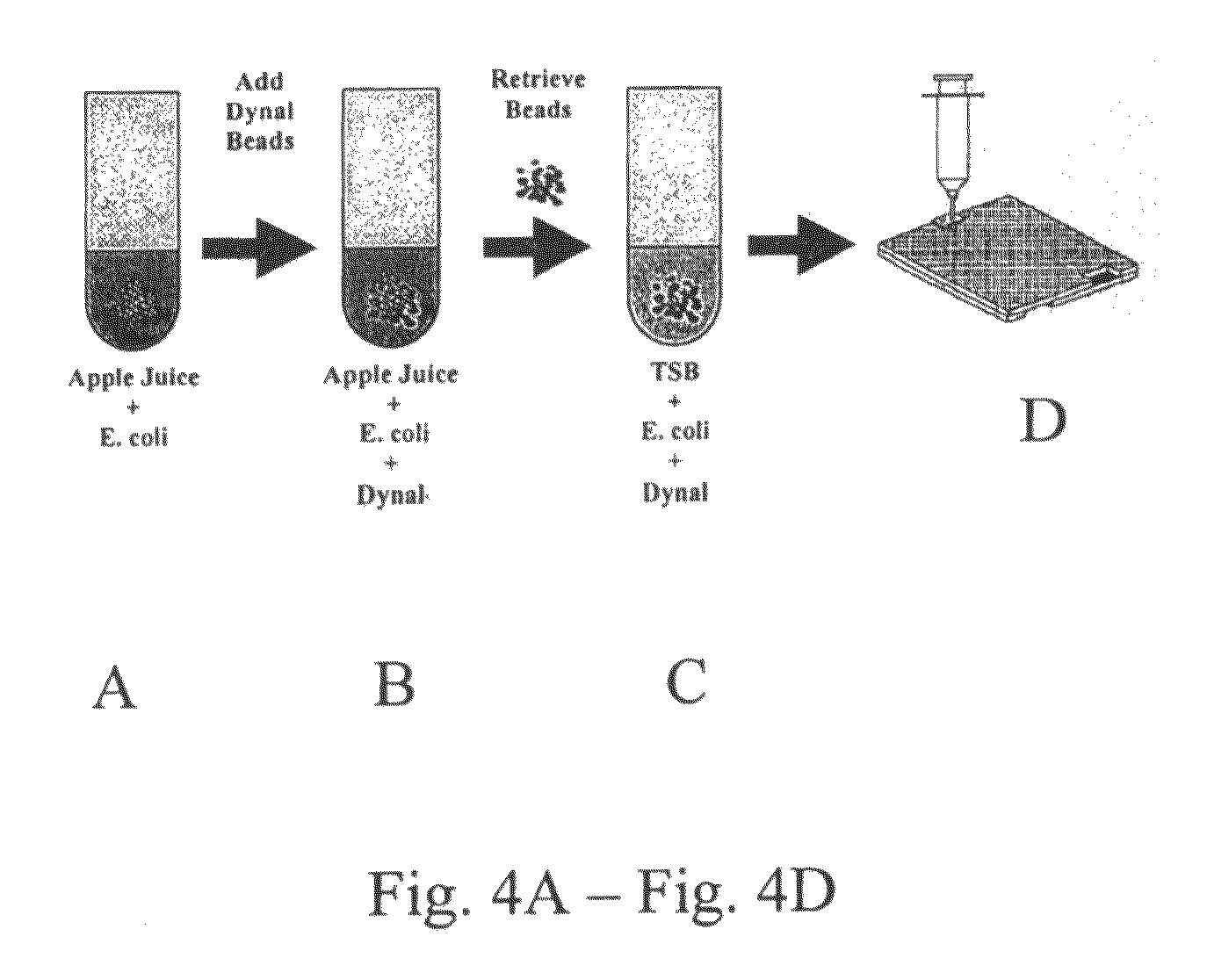Method and composition for rapid viability testing of cells
a cell viability and cell technology, applied in the field of cell viability testing, can solve the problems of large societal resources, conventional approaches, and the dependence on the doubling time of the cell population, and achieve the effect of facilitating the rapid and reliable detection of viable cells and identification
- Summary
- Abstract
- Description
- Claims
- Application Information
AI Technical Summary
Benefits of technology
Problems solved by technology
Method used
Image
Examples
example 1
Initial Impedance Response From Heat-Shock Stressed Bacteria
[0084]It is known that bacterial metabolism following heat shock deviates significantly from that of unshocked bacterial cells. In this example, the ability to measure the initial impedance response from stressed bacterial cells during this recovery period is shown. First, the initial impedance response from un-shocked E. coli was measured. A single colony from overnight culture on Luria-Bertani Agar (LBA) (Becton Dickinson Microbiology Systems, Sparks, Md.) was picked with a sterile loop, re-suspended in TSB, and after appropriate dilution to approximately 1,000 Colony Forming Units per milliliter (103 CFU / ml) transferred directly into one of the impedance cassette chambers while the adjacent chamber was filled with TSB only. The cassette was inserted into the thermally controlled analyzer held at 37 degrees Celsius (37° C.) and the full impedance vector was recorded. In the data presented here, the capacitance components ...
example 2
Specific Detection of Cells.
[0091]As a demonstration of the rapid and specific detection of cells in a sample, data are presented for the capture and detection of E. coli in apple juice. A series of experiments were conducted to compare the detection of E. coli in deliberately contaminated apple juice monitoring directly the growth and stress response. A schematic description of the experimental procedure is shown in FIG. 4. A 10 ml volume of sterile apple juice was spiked with approximately 103 CFU / ml of E. coli O157:H7 (See FIG. 4A). Magnetic beads (Dynal Biotech, Oslo, Norway) pre-coated with antibodies specific for our strain on E. coli were added (See FIG. 4B).
[0092]Our protocol for cell capture strictly adhered to the manufacturer's recommendations. Once captured, the cell-antibody complexes were retrieved using the magnetic beads, and were washed and re-suspended in TSB (See FIG. 4C), and the resulting suspension was loaded into the cassette (See FIG. 4D). The adjacent chambe...
example 3
Impedance Response During the Initial 8 Hours of Growth of E. Coli
[0097]The impedance response recorded during the initial 8 hours of growth of E. coli (spike −120 CFU / ml) retrieved from spiked apple juice is plotted in FIG. 8. The initial 120 minutes of the measurement have been expanded and re-plotted as an insert in the same figure. The negative sloping response seen during the first 30 minutes prior to the onset of the well-defined increasing signal is interpreted as biological activity of the viable but not dividing cells experiencing the so called “new medium” stress. In classical microbiology, this period of bacterial growth is called the lag phase or time necessary for bacterial adaptation to new culture conditions. The microbial lag phase is a complex and yet not completely understood phenomenon. We note that 1.) the Impedance Response from stressed cells is similar to that from un-stressed cells during lag phase and 2.) stressed cells returning to optimal growth condition...
PUM
| Property | Measurement | Unit |
|---|---|---|
| volume | aaaaa | aaaaa |
| volume | aaaaa | aaaaa |
| concentrations | aaaaa | aaaaa |
Abstract
Description
Claims
Application Information
 Login to View More
Login to View More - R&D
- Intellectual Property
- Life Sciences
- Materials
- Tech Scout
- Unparalleled Data Quality
- Higher Quality Content
- 60% Fewer Hallucinations
Browse by: Latest US Patents, China's latest patents, Technical Efficacy Thesaurus, Application Domain, Technology Topic, Popular Technical Reports.
© 2025 PatSnap. All rights reserved.Legal|Privacy policy|Modern Slavery Act Transparency Statement|Sitemap|About US| Contact US: help@patsnap.com



